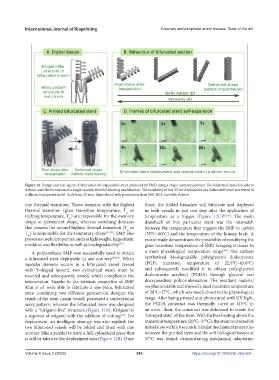Page 251 - IJB-9-2
P. 251
International Journal of Bioprinting Coronary and peripheral artery disease. State of the art.
Figure 12. Design and real aspect of bifurcated self-expandable stent produced by FMD using a shape memory polymer. The bifurcated branch is able to
deform until the formation of a single conduit, thereby allowing implantation. The suitability of this VS for deployment in a bifurcated vessel was tested in
a silicon, transparent mold. Scale bars: 20 mm. Reproduced with permission from [66] 2018, Scientific Reports.
one thermal transition. Those domains with the highest there, the folded branches will bifurcate and deployed
thermal transition (glass transition temperature, T or in both vessels in just one step after the application of
g
melting temperature, T ) are responsible for the memory temperature as a trigger (Figure 12C) [65,66] . The main
m
shape or permanent shape, whereas switching domains drawback of this particular stent was the mismatch
that possess the second highest thermal transition (T or between the temperature that triggers the SMP to unfold
g
T ) is responsible for the temporary shape [97,98] . SMP also (55°C–60°C) and the temperature of the human body. A
m
possesses useful properties, such as lightweight, large elastic recent study demonstrates the possibility of modifying the
modulus and flexibility, as well as biodegradability . glass transition temperature of SMP, bringing it closer to
[97]
[64]
A polyurethane SMP was successfully used to obtain a more physiological temperature range . The authors
a bifurcated stent deployable in just one step [65,66] . When synthetized biodegradable poly(glycerol dodecanoate
vascular stenosis occurs in a bifurcated vessel (vessel (PGD, transition temperature of 22.5°C–43.6°C)
with Y-shaped lumen), two cylindrical stents must be and subsequently modified it to obtain poly(glycerol
inserted and subsequently joined, which complicates the dodecanoate acrylate) (PGDA) through glycerol and
intervention. Thanks to the intrinsic properties of SMP, docecanedioic polycondensation. The resultant material
Kim et al. were able to fabricate a one-piece, bifurcated wa photocurable and showed a final transition temperature
stent combining two different geometrical designs: the of 20°C–37°C, which was much closer to the physiological
trunk of the stent (main vessel) possessed a conventional range. After being printed and photocured with UV light,
wavy pattern, whereas the bifurcated zone was designed the PGDA construct was thermally cured at 145°C in
with a “kirigami-like” structure (Figure 12A). Kirigami is an oven. Then, the construct was deformed to create the
[66]
a superset of origami with the addition of cutting . For “crimped state” of the stent. With further heating above the
deployment, an intelligent strategy was also applied: the transition temperature (20°C–37°C), the stent recovered its
two bifurcated vessels will be folded and fitted with one initial state within 8 seconds. Similar mechanical properties
another (like a puzzle) to form a full, cylindrical piece that between the printed stent and the soft biological tissues at
is will be taken to the deployment area (Figure 12B). Once 37°C was found, demonstrating mechanical adaptation
Volume 9 Issue 2 (2023) 243 https://doi.org/10.18063/ijb.v9i2.664

